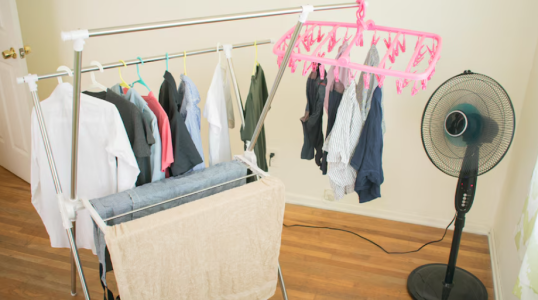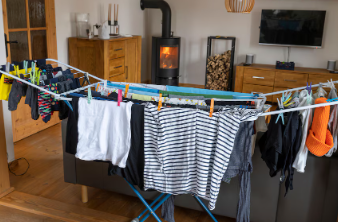How to dry laundry without a dryer when it's cold or wet outside
By
ABC News
- Replies 1
Getting clothes and linen dry in constant wet weather can be frustrating.
Maybe you don't have the luxury of a tumble dryer, or you're reluctant to use it to save on your next power bill.
Add a sudden drop in temperature and the process of drying our washing can become even tricker.
Some experts, like Lish Fejer, a science communicator and ABC reporter in Ngambri/Canberra, discourage the use of tumble dryers because of the amount of energy they consume and the impact they can have on your clothes.
"[Tumble] drying is bad for your clothes; it wears them down," Lish says.
Lish runs The Fix It Chicks with co-creator Jenny Edwards, teaching people cheap ways to wash and dry laundry.
Here are some of the alternative methods you can use for drying clothes and linen in wet or cold weather.
Air drying
If the clothes can withstand it (avoid wool, linens and silks, for example), put them on a high-spin cycle in the washing machine, and repeat.
"You can give drying a head start by spinning to get rid of as much water as possible," Lish says.
When you take your clothes out of the washing machine, she suggests rolling them up in a clean, dry towel to remove excess moisture.
Lish says when using a rack for air drying, make sure the clothes are spaced out well so air can circulate around each item. Using pegs means you won't have to fold the items over.
"Look at any glass or window that is being hit by the sun — put your drying rack there, that will activate the drying process," Lish says.
If heading out for the day, hang sheets and towels over chairs and tables.
"I love a coat hanger; I hang shirts on them and put them over door frames and architraves."
Fan power
Ventilation is important to minimise condensation and avoid mould.
"Humidity in the house is a big one [if drying clothes indoors]," says Lish.
"How do you get rid of that moisture in your house without it causing mould and mildew and the health effects that come with that?"
She recommends opening a window to manage this (weather dependent).
You can also increase air flow indoors by using a pedestal or ceiling fan which Lish says uses little energy and helps with evaporation.
The extraction fan in your bathroom will be effective when drying in there.
Some split-system air conditioners have a dehumidifying mode that doesn't cool or heat (and therefore costs less to run).
Embrace unconventional methods
Drying happens best outside, so if you have the space, take advantage.
If its overcast or rainy, using a balcony or undercover area is ideal — even if shady and cold.
A windy day is a bonus, as items will dry faster.
If you're strapped for time (or motivation), throw the wet load of washing onto an outdoor table on a towel in the sun, on a picnic blanket, on the trampoline, or on the heated floor.
For small items, Lish lays them on a towel in the back of her car and parks it in the sun while at work.
"You do have to occasionally go turn them over, and I leave the windows open a little."
If you have a hot water system in the cupboard, you could also fold clothes that are nearly dry and place them on top.
"Be careful not to cover the pressure valve," warns Lish.
If you are using a clothes dryer...
Lish says to throw in a clean, dry towel with your wet items.
"That will significantly reduce the amount of time it needs to be on for as it absorbs some of the moisture."
Susan Toft, the CEO and founder of a nationwide domestic laundry business, says the biggest mistake people make is simply "putting items in that are not meant for the dryer, because you can damage them".
"Wool, in particular, will shrink. And that's probably the thing we see the most," she says.
But, she says, you should also take great care with bras, other delicate items (such as anything with silk), and clothing with prints on it.
"The best tip is to always follow the care label," she says.
Consumer advocacy group CHOICE also advises caution when drying anything with lycra in it — so throwing in your activewear might not be the best bet.
But if you do end up shrinking something, it's not the end of the world.
For jumpers, you can wet them and pat them out with towels to try and stretch them back out, and then leave them to dry in a shady spot.
Written by Amy Sheehan, ABC News.
Maybe you don't have the luxury of a tumble dryer, or you're reluctant to use it to save on your next power bill.
Add a sudden drop in temperature and the process of drying our washing can become even tricker.
Some experts, like Lish Fejer, a science communicator and ABC reporter in Ngambri/Canberra, discourage the use of tumble dryers because of the amount of energy they consume and the impact they can have on your clothes.
"[Tumble] drying is bad for your clothes; it wears them down," Lish says.
Lish runs The Fix It Chicks with co-creator Jenny Edwards, teaching people cheap ways to wash and dry laundry.
Here are some of the alternative methods you can use for drying clothes and linen in wet or cold weather.
Air drying
If the clothes can withstand it (avoid wool, linens and silks, for example), put them on a high-spin cycle in the washing machine, and repeat.
"You can give drying a head start by spinning to get rid of as much water as possible," Lish says.
When you take your clothes out of the washing machine, she suggests rolling them up in a clean, dry towel to remove excess moisture.
Lish says when using a rack for air drying, make sure the clothes are spaced out well so air can circulate around each item. Using pegs means you won't have to fold the items over.
"Look at any glass or window that is being hit by the sun — put your drying rack there, that will activate the drying process," Lish says.
If heading out for the day, hang sheets and towels over chairs and tables.
"I love a coat hanger; I hang shirts on them and put them over door frames and architraves."
Fan power
Ventilation is important to minimise condensation and avoid mould.
"Humidity in the house is a big one [if drying clothes indoors]," says Lish.
"How do you get rid of that moisture in your house without it causing mould and mildew and the health effects that come with that?"
She recommends opening a window to manage this (weather dependent).
You can also increase air flow indoors by using a pedestal or ceiling fan which Lish says uses little energy and helps with evaporation.
The extraction fan in your bathroom will be effective when drying in there.
Some split-system air conditioners have a dehumidifying mode that doesn't cool or heat (and therefore costs less to run).
Embrace unconventional methods
Drying happens best outside, so if you have the space, take advantage.
If its overcast or rainy, using a balcony or undercover area is ideal — even if shady and cold.
A windy day is a bonus, as items will dry faster.
If you're strapped for time (or motivation), throw the wet load of washing onto an outdoor table on a towel in the sun, on a picnic blanket, on the trampoline, or on the heated floor.
For small items, Lish lays them on a towel in the back of her car and parks it in the sun while at work.
"You do have to occasionally go turn them over, and I leave the windows open a little."
If you have a hot water system in the cupboard, you could also fold clothes that are nearly dry and place them on top.
"Be careful not to cover the pressure valve," warns Lish.
If you are using a clothes dryer...
Lish says to throw in a clean, dry towel with your wet items.
"That will significantly reduce the amount of time it needs to be on for as it absorbs some of the moisture."
Susan Toft, the CEO and founder of a nationwide domestic laundry business, says the biggest mistake people make is simply "putting items in that are not meant for the dryer, because you can damage them".
"Wool, in particular, will shrink. And that's probably the thing we see the most," she says.
But, she says, you should also take great care with bras, other delicate items (such as anything with silk), and clothing with prints on it.
"The best tip is to always follow the care label," she says.
Consumer advocacy group CHOICE also advises caution when drying anything with lycra in it — so throwing in your activewear might not be the best bet.
But if you do end up shrinking something, it's not the end of the world.
For jumpers, you can wet them and pat them out with towels to try and stretch them back out, and then leave them to dry in a shady spot.
Written by Amy Sheehan, ABC News.









